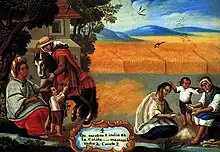
De Mestizo y de India; Coyote. Miguel Cabrera, 1763, oil on canvas, Waldo-Dentzel Art Center.

De mestizo e india, sale coiote. Anonymous, 18th century (From a Mestizo man and an Amerindian woman, a coyote is begotten).

De Castizo y India, Coyota. Anonymous, 18th century Mexico.
Coyote (fem. Coyota) (from the Nahuatl word coyotl, coyote) is a colonial Spanish American racial term for a mixed-race person casta that usually refers to a person born of parents, one of whom a Mestizo (mixed Spanish + Indigenous) and the other indigenous (indio).
Representation
The casta paintings by Miguel Cabrera (1763) show the place of the coyote in the idealized colonial racial hierarchy (sistema de castas).[1] In colonial Mexico, the term varied regionally, with "regional differences determin[ing] just how much native ancestry qualified a person to be a coyote."[2]
See also
References
Further reading
- Katzew, Ilona. Casta Painting: Images of Race in Eighteenth-Century Mexico. New Haven: Yale University Press 2004.
This article is issued from Wikipedia. The text is licensed under Creative Commons - Attribution - Sharealike. Additional terms may apply for the media files.